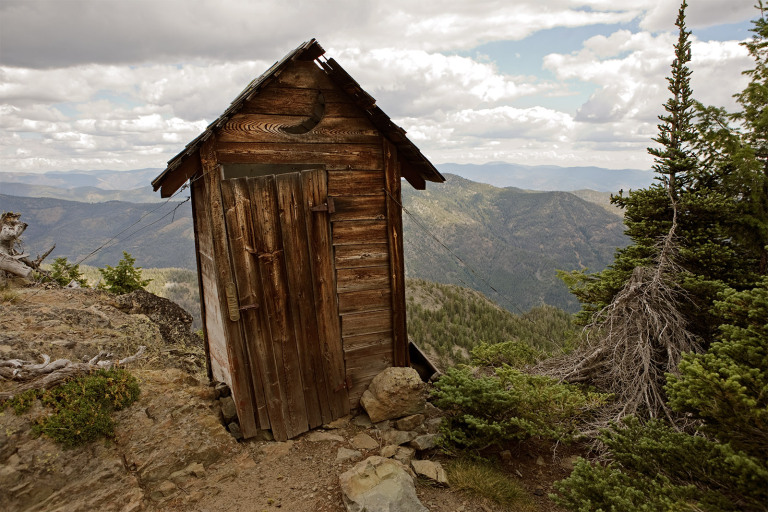
Report Date:
http://californiaoutdoorsqas.com
Question: My question is in regard to hunting near an outhouse located by a paved parking lot at a trailhead within the Cleveland National Forest. This parking lot has a pit toilet building only. I am well aware of the law that says you cannot shoot a firearm within 150 yards of an occupied building, but this outhouse is an obvious one that can only be “occupied” temporarily. Do the same rules apply to that building as an occupied residence or dwelling? Are there other restrictions or safety zone requirements regarding hunting near a paved area? (James V., San Diego)
Answer: The law prohibits hunting or discharging a firearm or other deadly weapon (such as bows or crossbows) while hunting within 150 yards of an occupied dwelling house, residence, or other building … or over a public road or other established way open to the public (Fish and Game Code, section 3004(a)(b)). Parking lots and trailheads qualify as “established ways open to the public” and that outhouse is an “other building,” so the 150-yard safety zone would apply at this location. For more information regarding hunting in the Cleveland National Forest, please check out the U.S. Forest Service website.
Gaffing/retrieving fish caught from a pier?
Question: I purchased a telescoping pier net to land large fish (striped bass, salmon, etc.) from municipal piers in the Bay Area. It is still not long enough to reach the surface of the water, especially at low tide. Would a pier gaff be an acceptable/legal method to land these fish? (Mitch R., San Jose)
Answer: A pier gaff would be legal as long as you are certain the fish you plan to gaff is a legal fish and one that you intend to keep. Keep in mind that it is unlawful to use a gaff hook to assist in landing or to land a fish less than legal size (California Code of Regulations Title 14, section 28.65).
A safer and probably easier alternative is to lower a hoop net down via a long attached rope, get it under the large fish to secure it, and then hoist it up safely to the surface. Then, once you have the fish in hand, you can keep it if it’s legal and desirable, or if you choose not to keep it, simply remove the hook and send it back down via the hoop net “elevator” to the water below. Then you can allow it to swim out and watch as it swims back to where it came from.
Steelhead trout for sale commercially?
Question: Can steelhead be sold commercially? (Phillip W.)
Answer: Wild steelhead harvested in waters of the state of California cannot be sold commercially. Wild steelhead trout harvested from outside the state may be possessed and sold within the state when they are inspected and tagged in compliance with Fish and Game Commission regulations. The cost of such tagging and inspection must be paid by the person importing the wild steelhead (Fish and Game Code, section 8431). Steelhead trout grown in the state or imported here by a registered aquaculturist for aquaculture purposes may be sold commercially as long as they are in compliance with all applicable aquaculture rules and regulations.
Reselling animal parts donated to charity thrift stores?
Question: We operate several charity thrift stores and local community members often donate various types of animals to us to resell. Are we allowed to resell animal parts that we receive via donations? Examples would be antlers, busts, skulls, fur jackets, bear rugs, mounted fish, etc. We currently do not sell these items, but we do want to make sure we maximize our profits for our charity. (Briana G., El Dorado County)
Answer: Even though the animal parts are donated, it is still unlawful to resell them in most instances. “It is unlawful to sell or purchase a bird or mammal found in the wild in California” (Fish and Game Code, section 3039).
There are some exceptions, such as products made from furbearing mammals and nongame mammals (possibly a fur coat) lawfully taken under the authority of a fur-bearing license. Also, shed antlers or antlers taken from domestically reared animals that have been manufactured into products or handicrafts are exempt (FGC, section 3039). Parts from animals not found in the wild in California, such as a caribou, white tailed deer or moose are legal to sell.
Carrie Wilson is a marine environmental scientist with the California Department of Fish and Wildlife. While she cannot personally answer everyone’s questions, she will select a few to answer each week in this column. Please contact her at CalOutdoors@wildlife.ca.gov.Report Date:
The California Department of Fish and Wildlife (CDFW) is expanding its Lands Pass Program to 41 wildlife areas and ecological......
Report Date:
The California Department of Fish and Wildlife (CDFW) is offering waterfowl hunting opportunities at the Eden Landing Ecological Reserve (ELER)......